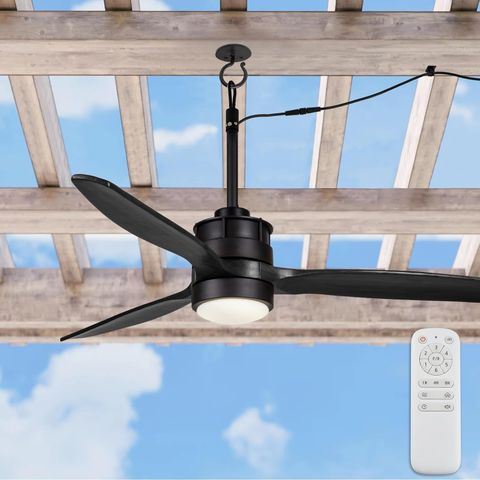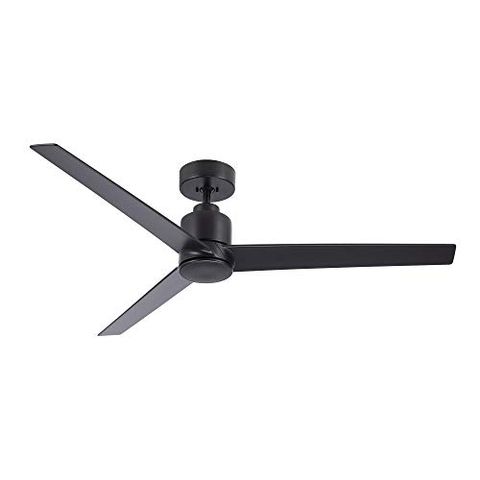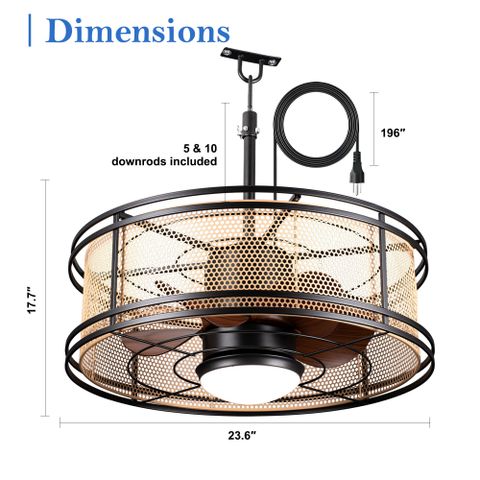Outdoor dining is one of life’s simple pleasures, but it can quickly turn into a sweltering ordeal when the heat gets overwhelming. The secret to a successful outdoor dining experience lies in balancing comfort with style – and weatherproof fans play a crucial role in achieving that balance.
There’s something magical about sharing a meal under the open sky. Whether it’s a backyard barbecue, a restaurant patio, or a garden gathering, outdoor dining brings people together in ways that indoor settings simply cannot match. But let’s be honest – the summer months can transform a lovely evening into an uncomfortable struggle against the elements. The good news? With the right approach and some thoughtful fan selection, you can create an environment where guests feel refreshed rather than roasted.
Understanding Weatherproof Fan Basics
Before diving into specific recommendations, it’s important to grasp what makes a fan truly weatherproof. These aren’t just regular ceiling fans that get a quick coat of paint. They’re engineered to withstand rain, humidity, and temperature fluctuations. Think of them as the unsung heroes of outdoor comfort.
Most weatherproof fans feature materials like aluminum or stainless steel construction. The blades themselves are often made from durable plastics or metals that won’t warp or break in extreme conditions. Additionally, they have special coatings or finishes that resist corrosion and UV damage. Some even come with waterproof ratings that specify exactly how much moisture they can handle.
Consider the difference between a basic indoor fan and a weatherproof model. An indoor fan might last years in controlled conditions, but expose it to the elements and you’ll find yourself replacing it within months. A quality weatherproof fan, however, can serve you well for decades when properly maintained.
Choosing the Right Fan Size and Type
Not all fans are created equal, especially when it comes to outdoor spaces. The size and type of fan you choose directly impacts how effectively it cools your area.
For smaller outdoor dining areas like patios or deck spaces, a ceiling-mounted fan with a diameter of 42 inches works well. These fans can move enough air to create a comfortable breeze without overwhelming the space. You’ll want to look for models specifically rated for outdoor use.
Larger areas benefit from larger fans. A 52-inch or 60-inch ceiling fan can cover more ground and provide better circulation. Some installations even combine multiple fans to ensure consistent airflow throughout the entire dining area.
Another option worth considering is the wall-mounted fan. These can be particularly useful in spaces where ceiling installation isn’t feasible or desired. They offer similar cooling benefits while taking up less vertical space.
When it comes to blade design, curved blades typically provide better airflow than straight-blade options. Look for fans with at least three blades for optimal performance. Some manufacturers even offer fans with adjustable blade angles, allowing you to fine-tune the airflow direction based on wind conditions.
Installation Considerations and Mounting Options
Proper installation is half the battle when it comes to outdoor fan success. Unlike indoor fans where mounting is relatively straightforward, outdoor installations require extra attention to detail.
Ceiling mounting is usually the preferred option for most outdoor dining areas. However, the mounting hardware must be specifically designed for outdoor use. This means looking for brackets that are rust-resistant and capable of handling the additional weight of outdoor fans.
Height matters significantly in outdoor installations. Fans should hang at least 9 feet above the ground to ensure safety and proper airflow. In some cases, especially with taller ceilings, you might need to consider additional support structures.
Wall mounting offers flexibility for spaces with limited ceiling clearance. These mounts need to be securely anchored to structural elements like studs. Many wall mounts come with adjustable angles, allowing you to direct airflow where it’s needed most.
Don’t forget about electrical considerations. Outdoor installations require GFCI protection to prevent electrical hazards. This means having a dedicated circuit that can handle the fan’s power requirements while maintaining safety standards.
Weather Resistance Features to Look For
A truly weatherproof fan goes beyond just being able to get wet occasionally. It needs to handle the full spectrum of outdoor conditions.
Water resistance is perhaps the most critical feature. Look for fans with IP ratings – these indicate how well they protect against water ingress. An IP44 rating means protection against solid objects larger than 1mm and splashing water from any direction. For maximum protection, aim for IP65 or higher ratings.
Corrosion resistance becomes important in coastal areas or regions with high humidity. Stainless steel components and powder-coated finishes help prevent rust and degradation. Some fans even feature special coatings that resist salt damage.
Temperature tolerance matters too. Fans should function effectively in both hot summer days and cooler evenings. The motor and electronics need to handle thermal expansion and contraction without failing.
UV protection prevents fading and material breakdown from prolonged sun exposure. Quality weatherproof fans use UV-stabilized materials that maintain their appearance and functionality over time.
Energy Efficiency and Operating Costs
While we want our outdoor fans to provide excellent cooling, we also need to consider their impact on energy consumption. After all, nobody wants to spend a fortune on electricity to keep guests comfortable.
Modern weatherproof fans are surprisingly efficient. Many now feature energy-saving motors that consume less power while delivering adequate airflow. LED lighting integrated into some fan designs provides illumination without adding significant energy costs.
Variable speed controls allow you to adjust airflow based on actual needs. When the breeze is gentle, you can reduce speed to save energy. During peak heat hours, you can increase speed for maximum comfort.
Consider timing controls and smart features. Some fans can be programmed to run during specific hours or automatically adjust based on ambient temperature. This ensures you’re not wasting energy when outdoor dining isn’t happening.
Long-term operating costs also factor into the decision. While premium weatherproof fans may cost more upfront, their durability often means fewer replacements and lower maintenance expenses over time.
Maintenance and Longevity Tips
Investing in quality weatherproof fans pays off in longevity, but proper maintenance is still essential for optimal performance.
Regular cleaning prevents dust buildup that can reduce efficiency. Remove fans seasonally and clean blades with mild soap and water. Pay special attention to the motor housing and electrical components.
Check fasteners periodically to ensure everything remains secure. Outdoor conditions can loosen mounting hardware over time, potentially creating safety hazards.
Inspect electrical connections regularly. Corrosion can develop in humid conditions, leading to performance issues or safety concerns.
Some manufacturers recommend seasonal maintenance routines. These might include lubricating moving parts, checking wiring insulation, and testing all operational features.
Replacing worn parts promptly prevents small issues from becoming major problems. Many weatherproof fans have modular components that can be easily swapped out when necessary.
Creating the Perfect Outdoor Atmosphere
Fans are just one element of creating a comfortable outdoor dining experience. They work best when combined with other comfort factors.
Proper ventilation is crucial. While fans provide movement, they shouldn’t be the only source of air circulation. Consider the overall layout and how natural breezes might interact with mechanical airflow.
Shade plays a supporting role. Even the most effective fan can struggle to cool guests when they’re directly exposed to the sun. Strategic placement of umbrellas, pergolas, or shade structures can significantly improve comfort levels.
Temperature control extends beyond just cooling. Consider the ambient temperature and how it affects the dining experience. Sometimes a gentle breeze is more welcome than intense cooling.
Lighting adds another dimension to outdoor comfort. Proper illumination creates ambiance while ensuring safety. LED strips or pendant lights can enhance the overall experience.
Finally, think about the human element. Different people have different comfort preferences. Some enjoy a strong breeze, others prefer a light whisper. Designing around these varying needs helps create a more inclusive outdoor dining environment.
Common Mistakes to Avoid
Even with the best intentions, outdoor fan installations can go wrong if certain pitfalls are overlooked.
One common error is choosing a fan that’s too small for the space. A tiny fan in a large area won’t provide adequate cooling. Conversely, oversized fans can create uncomfortable drafts or overwhelm smaller spaces.
Ignoring weather ratings is another frequent mistake. Installing a fan rated for indoor use outdoors will likely result in early failure. Always verify that the fan meets outdoor specifications before purchasing.
Neglecting proper electrical installation is dangerous and expensive. Using incorrect wiring or lacking GFCI protection can lead to serious safety issues.
Poor mounting techniques cause many problems. Loose fans create noise and vibration issues. They also pose potential safety risks. Always follow manufacturer instructions carefully.
Overlooking maintenance requirements means missing opportunities to extend fan life. Regular care keeps systems running smoothly and prevents costly repairs.
Finally, failing to consider the overall environment can undermine even the best fan choice. Factors like prevailing winds, nearby structures, and local climate all influence how well fans perform.
Creating a comfortable outdoor dining experience isn’t just about good food and pleasant company – it’s about understanding how environmental factors affect guest comfort. Weatherproof fans represent a simple yet powerful solution to one of summer’s biggest challenges.
The key lies in making informed decisions about fan size, type, installation, and maintenance. When these elements align correctly, you’re not just providing cooling; you’re creating an environment where people want to stay longer, return again, and share their positive experiences with others.
Whether you’re planning a weekend barbecue or designing a restaurant patio, investing in quality weatherproof fans shows respect for your guests’ comfort. It demonstrates attention to detail and a commitment to excellence that turns ordinary outdoor meals into memorable experiences.
Remember, the goal isn’t just to keep guests cool – it’s to create a space where they feel genuinely comfortable and enjoy their time outdoors. With the right approach to weatherproof fans, that goal becomes achievable year-round.














